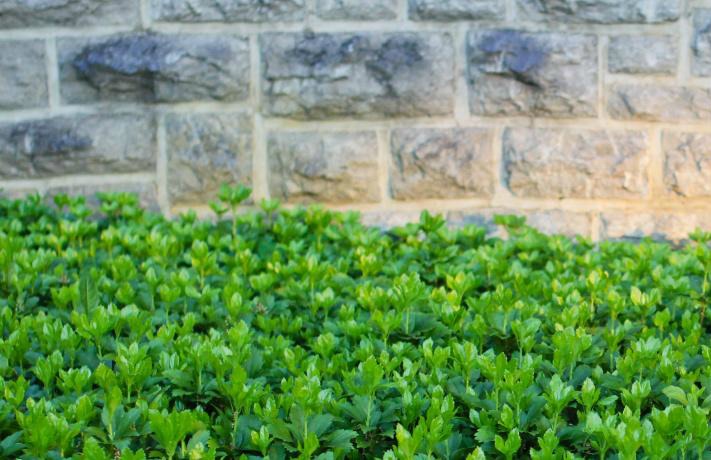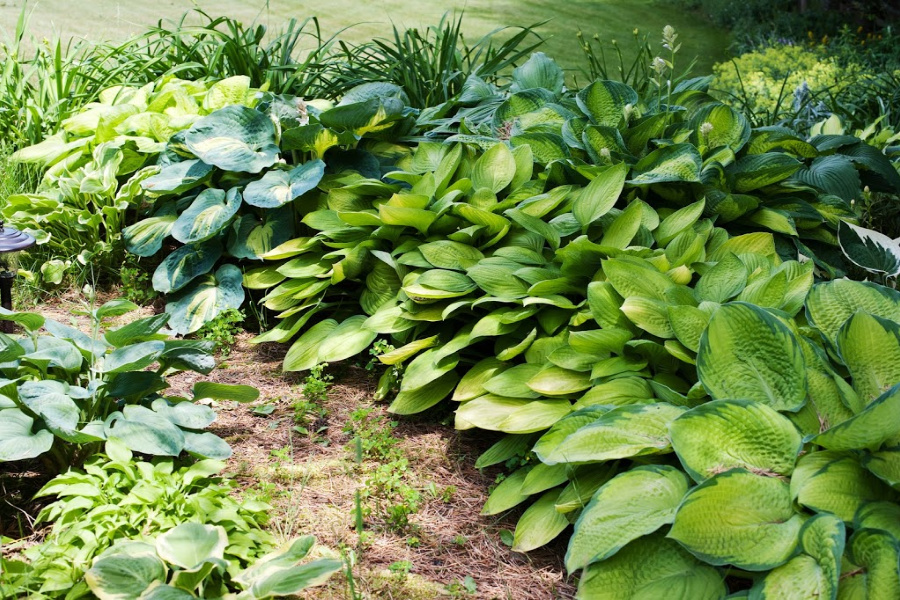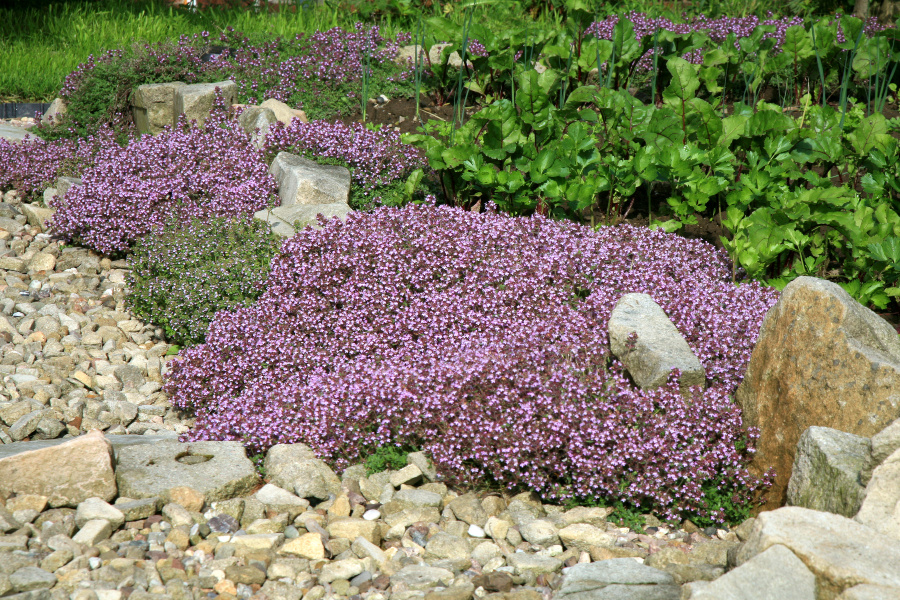
Ground Covers: Enhancing Commercial Landscapes
Reducing the natural challenges commercial landscapes encounter

In the landscaping world, ground covers refer to the typically perennial, low-lying plants that spread and creep across sections of your grounds. They provide visible appeal with minimal maintenance.
Similar to mulch, ground cover plants provide a cost-effective means to cover the soil, creating interest, and finishing the design look of any landscape. These dependable and hardworking plants come in a wide variety of color and texture choices and solve a variety of landscaping challenges.
Ground Cover Contributes to Soil Care
Improves Soil Quality: Ground cover improves the humus levels in the soil. In its simplest description, humus is a slow-release organic fertilizer for your plants that is found in the soil. The more organic matter in the soil, the richer the humus content and the better chances all the plants will thrive.
Provides Soil Insulation: Ground cover plants offer a layer of protection and insulation. In the hot summer months, the plants help maintain the soil's cool temperature, trapping in moisture levels. This can result in less need for supplemental watering and, in turn, saves you money. During the winter months, they help warm the earth, protecting plant roots from the low temperatures in colder seasons.
Prevents Soil Erosion: Perfect for sloping areas or hillsides, some ground cover plants help protect the soil from eroding. They also protect the landscape from soil erosion during high winds and heavy rains.
Evergreens
Evergreens are by far the most popular type of ground covers and keep their color year-round. They have the ability to turn what could have been a bleak and dead-looking landscape into one that is lush in every season. As a bonus, they require little to no maintenance and grow in a variety of regions, soils, and sun conditions. Ground covers can also help minimize weeds in two ways. First, by covering the soil so that weed seeds have a harder time germinating. Second, once the ground cover matures, weeds are physically suppressed from growing.
As the country’s largest commercial landscape company, BrightView has a vast knowledge of which plants work best in which environments. Discover some of our favorite ground covers and the challenges they overcome below.
Landscaping Challenges
1. Zones
Not all plants are suited to grow in all climates and conditions. So how do you know if the plant you fell in love with will flourish in your landscape? Fear not.
The U.S. Department of Agriculture has created a climate zone map that divides the country by zone boundaries. These zones correlate to the zone recommendations you will find on plants, shrubs, and trees from the growers.
2. Shade

Wet, shaded areas of your landscape can often drown out the roots of some plants.
- Sweet Woodruff: Ideal for Zones 4 to 8, they grow to a height of 6 to 12 inches with a spread of 9 to 18 inches. They flourish in dense shade and are perfect for below trees and shrubs. Their tiny white flowers will bloom in the early spring.
- Bishop's Weed: Ideal for Zones 4 to 9, they grow to a height of 12 inches and have an unlimited spread. This a fast-aggressive plant that comes in a variety of leaf choices, but works well in contained spaces, such as between buildings or a building and sidewalk. It is not evergreen as it does drop leaves in winter.
- Ajuga: Ideal for Zones 3 to 9, they grow to a height of 4 to 9 inches with an unlimited spread. Ajuga aggressively spreads via runners and can tend to be invasive if not controlled properly. It is ideal for large areas, helps to choke out weeds due to its denseness, and is resistant to deer. There is an array of varieties with leaf colors ranging from shades of green, maroon, bronze, purple, pink, or white. Tiny spikes of blue, pink, lavender, or white flowers will bloom on spikes in mid to late spring.
- Lamium: Ideal for Zones 3 to 8, they grow to a height of 6 to 8 inches and spread almost twice as wide. It has a delicate silver-marked foliage that tolerates cold, heat, and drought and is deer resistant.
- Hosta: Ideal for Zones 3 to 8, they grow to varying heights up to 2 feet with a spread from 4 inches up to 6 feet, depending on the variety. Their foliage ranges from forest and lime green to variegated and all white. From May through August, blooms of small white or purple blossoms on top of tall spikes are loved by hummingbirds and bees.
- Brass Buttons: Ideal for Zones 5 to 9, they grow to a height of 3 inches and spread up to 18 inches. They like moist, but well-drained soil. They feature textured, feathery foliage in shades of bronze-black to purple-gray and have small, button-like yellow-green blooms in late spring and early summer.
- Periwinkle: Ideal for Zones 4 to 8, they grow to a height of 3 to 6 inches and trailing vines that grow to 18 inches long. Their blue, lavender, purple, or white flowers bloom in the spring and sometimes have a second, though less spectacular showing in the summer. Incredibly adaptable, they can grow in full sun to full shade, can tolerate drought conditions, and even assist in preventing soil erosion. These almost self-maintaining vines are deer and rabbit resistant and are ignored by most insects.
3. Drought

If your region doesn't get a lot of rain, that doesn't mean you have to sacrifice colorful foliage. Plenty of ground covers can withstand the heat. Commercial landscapers are turning to drought-resistant plantings more often to preserve natural resources and save on costs. Here are a few of BrightView's favorites.
- Pink Creeping Myoporum: Ideal for Zones 8 to 9, they grow up to a height and spread of 9 inches. These west coast favorite, low growing shrubs prefer full sun. They are both deer resistant and fire defensible. Their small, white flowers appear in the spring and last through the summer.
- Dragon's Blood Sedum: Ideal for Zones 3 to 10, they grow to a height of 8 inches and spread up to 18 inches. They are super hardy, withstanding a wide range of temperatures and conditions and help to choke out weeds. During the summer, the succulent's leaves are a bright dark green with a burgundy edge. In the fall, those leaves turn to a deep dramatic red that gives the plant its name.
- Creeping Juniper: Ideal for Zones 3 to 10, they grow up to a height of 12 inches and spread as much as 8 feet. The leaves on this low-growing shrub have a blue tint in the warmer months and turn to a purple-red tint in colder months. Due to their spread, they assist in soil erosion.
- Lamb's Ears: Ideal for Zones 4 to 9, they grow to a height of 12- to 18-inches tall and spread as much as 12 inches, depending upon the variety. Growing in full sun or partial shade, they flower in summer with tiny white, pink, purple, violet, or red blooms, but its the fuzzy, silvery-green leaves that are the real attraction of these plants.
- Japanese Spurge: Ideal for Zones 4 to 8, they grow to a height of 6 inches and double that in width. An incredibly tolerant plant, it will grow in partial and/or full shade, drought conditions, and is resistant to pests. While it produces pretty white flowers in the spring, it is grown primarily for its dark, leathery green foliage.
- Creeping Phlox: Ideal for Zones 3 to 9, they grow to a height of 2 to 8 inches and spread from 9 to 24 inches. Preferring partial shade and average soil moisture, they are early spring bloomers with pink, purple, blue, and white star-shaped flowers.
- Nepeta: Ideal for Zones 3 to 8, they grow to a height of 10 to 24 inches and spread up to 24 inches. While flexible in their sun exposure - full sun to part shade - they prefer dry to medium moisture and well-drained soil. Its fuzzy, billowing foliage produces spikes of purple flowers in early summer, which return throughout the season.
- Creeping Thyme: Ideal for Zones 5 to 9, they grow up to 4-inches tall and are slow to spread to their ultimate 36 inches. They prefer moderate climates, but can withstand full sun and drougt-like conditions. Ideal for controlling weeds and repelling deer, they also attract butterflies, honeybees, and other cross pollinators.
- English Ivy: Ideal for Zones 4 to 9, they grow to a height of 6 inches with vines that can reach 24 inches. Incredibly tolerant, it will grow in partial and/or full sun and prefers well-drained soil, but will grow well in any soil condition. It covers the ground so thoroughly that it holds the ground together, presenting soil erosion while choking out the weeds.
Trust the BrightView Professionals
Your commercial landscape team of professionals at BrightView has the experience and knowledge to help you select the right ground cover for your region and property type.




